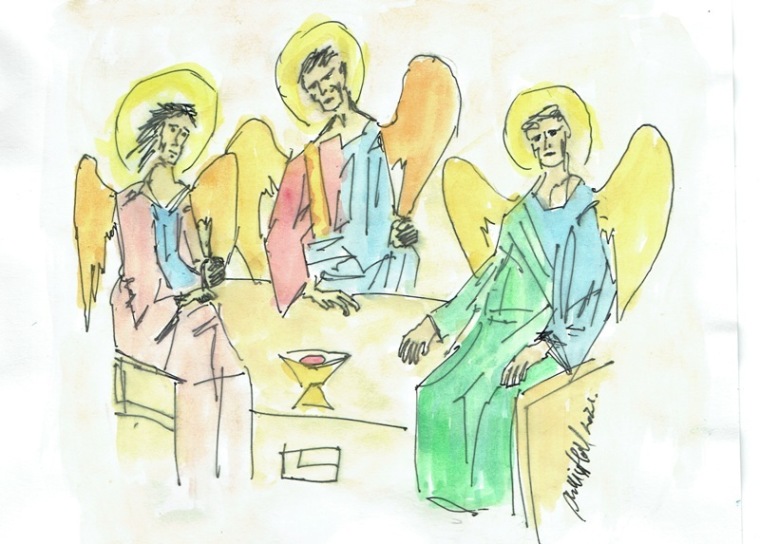
For many today the current ‘Church’ is a theatre, often inside an industrial warehouse. Worship is focused on the performance of the event and artistry in creating a cinema experience. The darkness forces the focus on the stage and the actors upon it.
This performance art has been taken from the world and translated into worship and is fairly recent. While not the same as High Church, Catholic or Orthodox worship; the difference between older and younger variants are obvious. It is like how you can date the church building by the shape of its interior and exterior.
Church Architecture and Art
If you enter a basilica in Rome like Santa Maria del Popolo you are focused on the Priest’s service of the Eucharist. Above where the Priest conducts the Eucharist, dominating the nave, is the painting of the Madonna with the Christ child.
When you enter an Orthodox church there is a plethora of the most amazing art. The Iconostasis promotes the saints, angels and the biblical narrative. You are confronted with a pictorial assault. It could only be more aggressive if it was in neon.
Protestants are not as sophisticated when it comes to art and faith. Nowhere near as sophisticated as their Catholic and Orthodox siblings. Protestant art is not bad, it does what it attempts to do, its just that it is often Kitsch.
Protestant Kitsch
Kitsch can be a slur. I too have used kitsch as a slur. Back when I was studying art and marvelling at Caravaggio, Bernini and Michelangelo. I was comparing elite artists with people who have little experience with art. Not nice of me at all.
Protestants have a history of art as taboo, or, outright evil. I remember my own journey into art and faith. It is very hard to sanctify that which has been demonised. To step outside of the boundaries and grasp an art form and bring it back into the world of faith and worship is difficult.
To immediately grasp any art form and take it into the worship culture is full of potholes. There will be efforts that, while being honest attempts at sanctification, will fall flat. The lack of sophistication is clunky, often with a forced symbolism that is, dare I say it again, kitsch.
Shemozzele and Schimck
To our rescue comes a unique word, Shemozzele. It is the total opposite of schmick. Schmick is what certain worship leaders aspire to. You know the type. They usually have a few Pentatonix albums. Though their heart is in the right place.
Schmick is cool, perfection, diamond. Shemozzele is a muddle, chaos, confusion. We are told to bring a joyful noise. No one said it had to be in tune. No one said it needed bells and smells, or even smoke machines and spotlights.
Is it possible to have a sophisticated shemozzele? Is there an example of a shemozzele that became sophisticated? Actually I think there is. Because to get from kitsch to sophistication requires time. Time the Catholic and Orthodox have had.
Ikonic Sophistication
Orthodox art in the form of the Iconostasis is sophisticated. Individual Ikons are made for worship and reflection. Gathered together and arrayed within the church building they became the Iconostasis. This took time to formalise and become what it is today.

Ikons are not Idols. There are strict rules for Ikons that were built up over time. Ikons are always flat and two dimensional. The third dimension is reflection and worship. Ikons are there to enable and focus your prayer. They reference significant biblical narratives and theological understandings.
You may have seen Ikons, I doubt you have seen Retalbos. Retablos are a fusion of art and personal prayer. An open and very honest expression that I describe as a shemozzele. Never before have I seen a form of visual art and faith so raw.
Retalbos?
Oh! You have not seen a Retalbo before? You do not know what one is for? Definition time. Retalbos are a votive offering made in the form of a religious picture typically portraying Christian saints, painted on a panel, and hung in a church or chapel especially in Spain and Mexico.
Retalbos paint the situation that the person is thanking the saint for helping them with. I do not pray to saints, those who paint Retalbos do. It is not the veneration of saints that define the shemozzele it is that some Retalbos feature true, awkward and often very graphic situations.
Sanctified Shemozzele
When we come to worship we do not come as a polished diamond, all schmick. We need to be sanctified by the work of God in our lives. While much of worship can seem formalised when it stutters, trips and falls flat, it is still worship.
We are human and not divine. Though some can perform and create at an elite level, not all can. We come as we are to the Almighty. Worship needs to be understood, so that the meanings of the actions, words, songs and symbols are known to all who come.
Worship can fall flat even when it is schmick, because the focus has shifted from the many to the few on stage. Our flaws are revealed in the action of worship because we are so far from the divine diamond standard.
We bring the shemozzele with us to be sanctified and made clean. Not to give the appearance of being clean. To have our worship perfection, to be schmick is to deny the work of God that is ongoing within. We hide the death inside like a white washed tomb.
I wanted so much to use actual Retalbos but I was not able to get permission to have them published along with this article. However a wonderful person has curated a blog with these raw visual prayers. It is raw and can be quite graphic, take this as a warning. If you can handle this please visit ithankthevirgin.tumblr.com.

Phillip Hall has been too long in Melbourne to see AFL in the same light as those back in Fremantle. East Fremantle born and bred, he would love to see the Dockers back in the eight. But would settle for just beating West Coast twice a year.